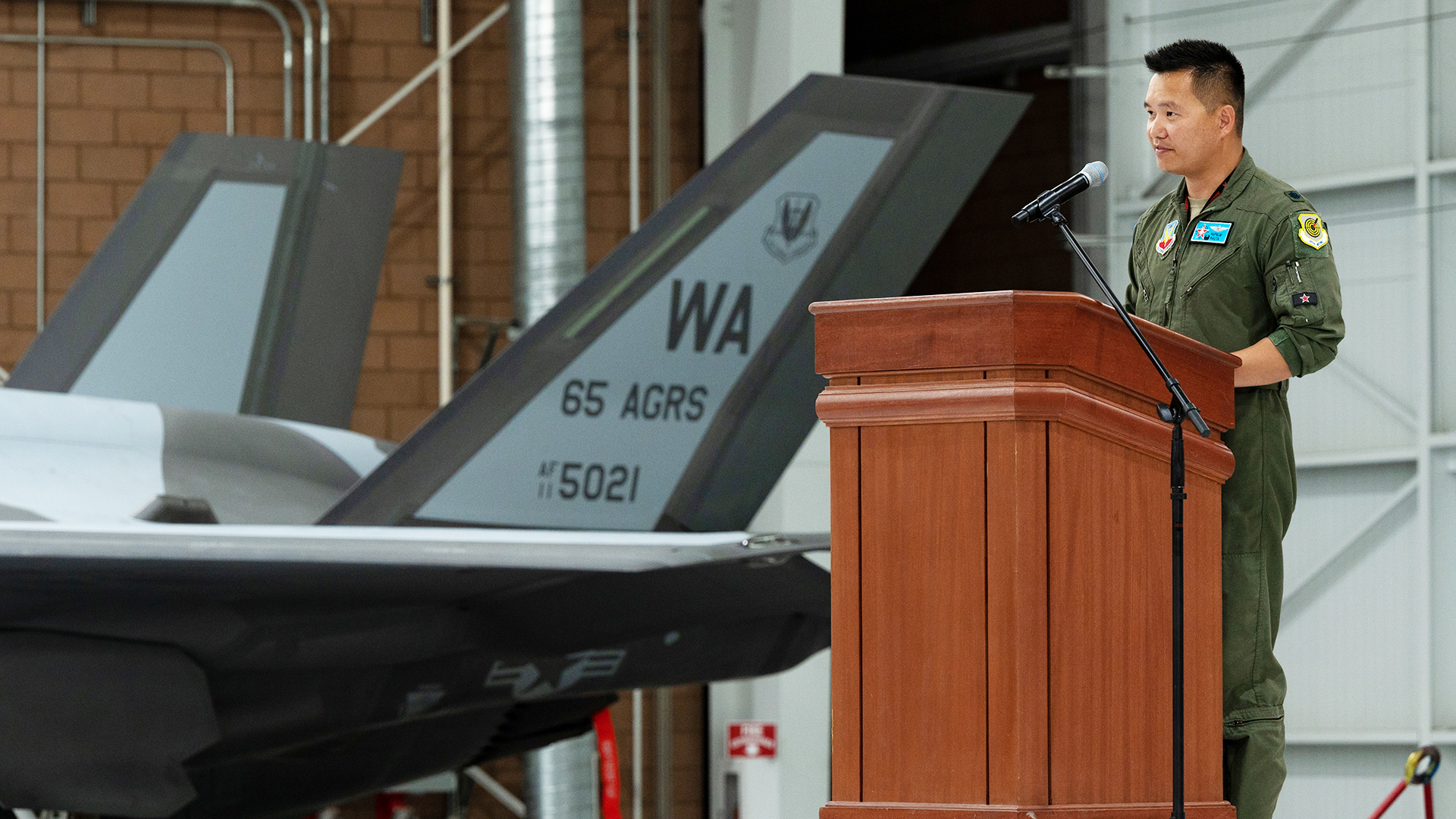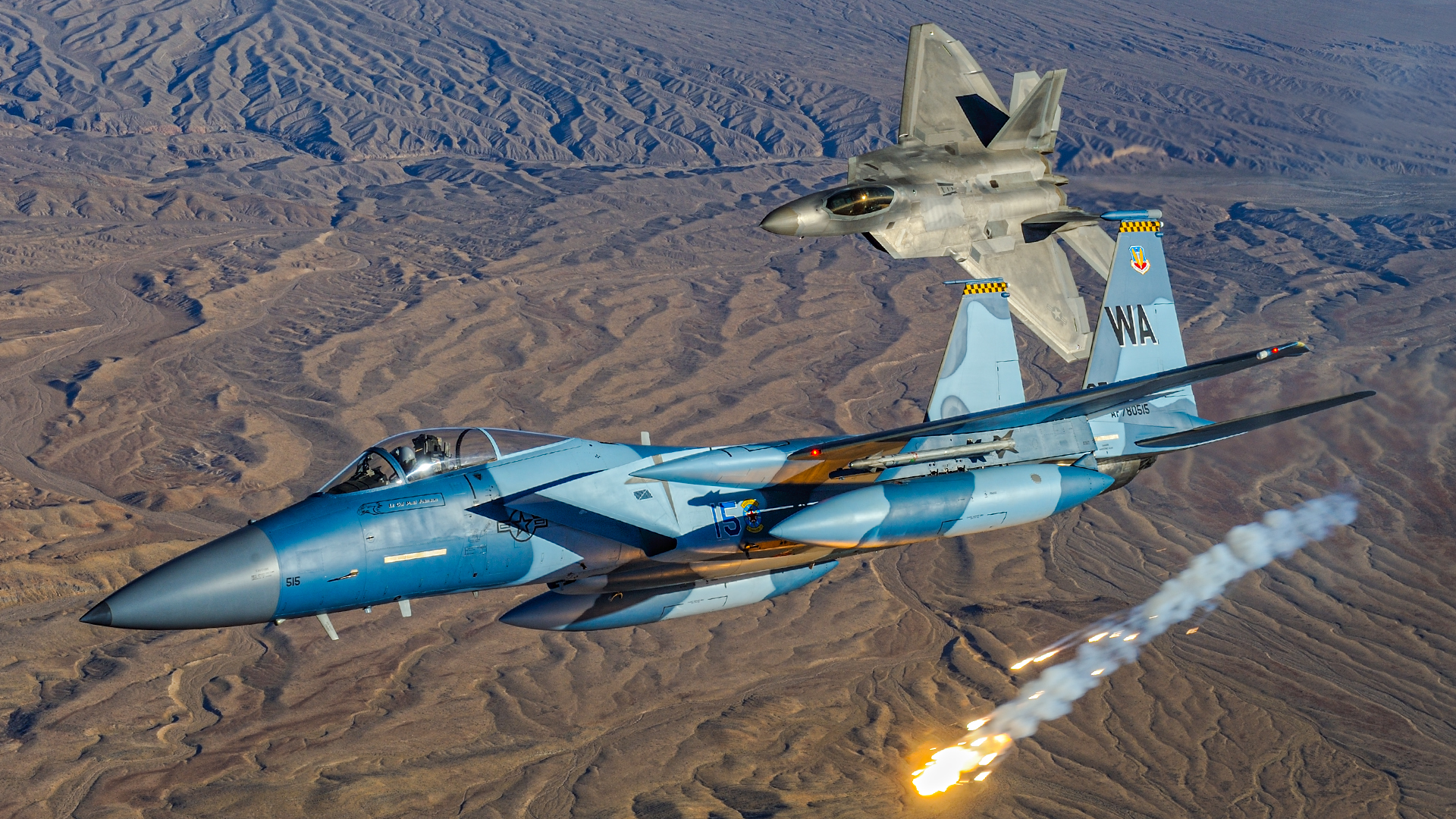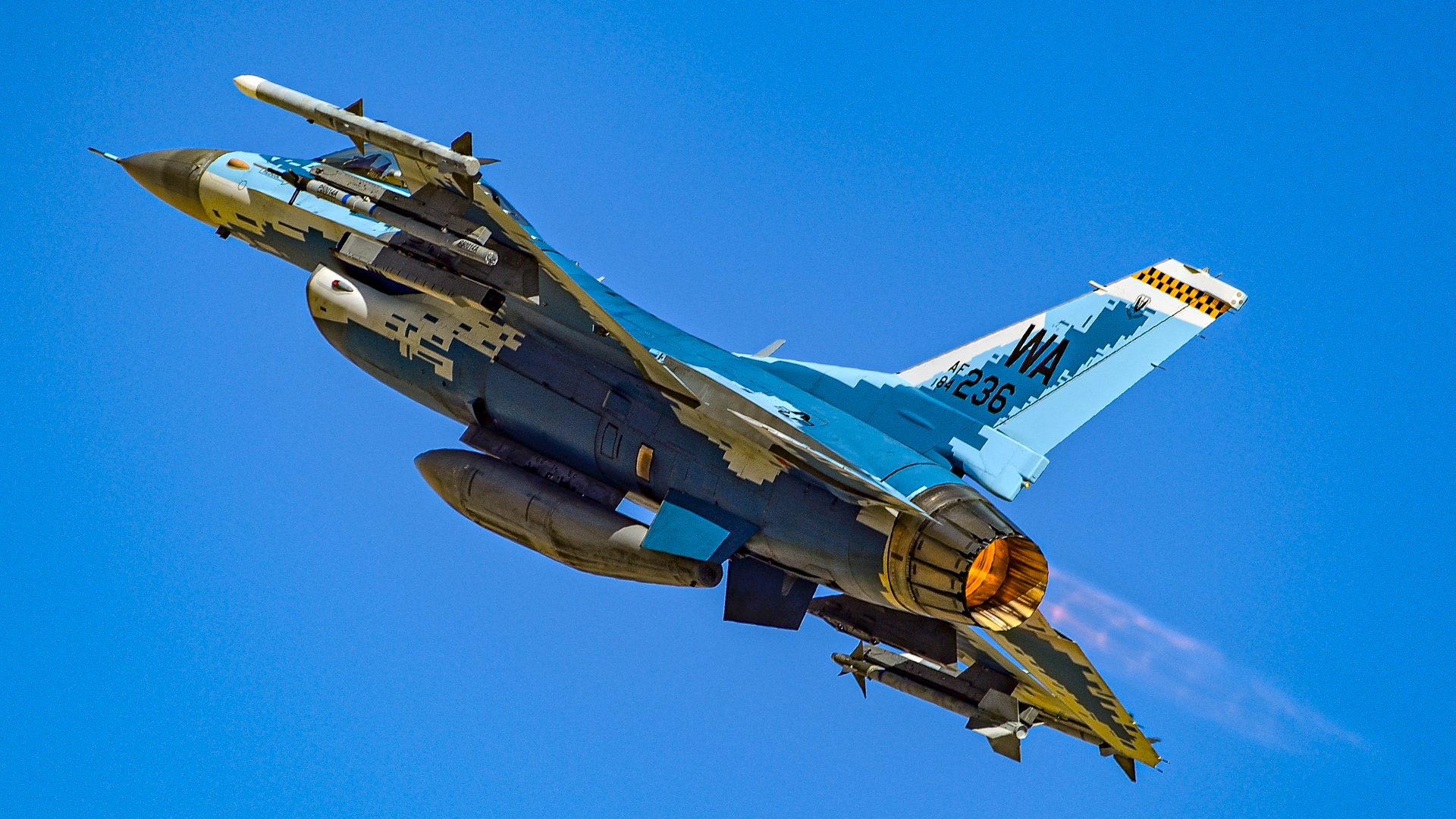The U.S. Air Force formally re-established the 65th Aggressor Squadron (AGRS) on June 9 at Nellis Air Force Base, Nevada. The unit will exclusively fly the F-35A Lightning II and dedicate its work to replicating the advanced airpower capabilities that are emerging from China. The first two aircraft to be assigned to the unit have been revealed in a new bespoke aggressor paint scheme that makes use of existing radar-absorbent coatings.
“Due to the growing threat posed by PRC [People’s Republic of China] fifth- and sixth-gen fighter development, we must use a portion of our daily fifth-generation aircraft today at Langley, Elmendorf, Hill, Eielson, and now Nellis, to replicate adversary fifth-generation capabilities,” said Air Combat Command commander Gen. Mark Kelly. “Precisely because we have this credible threat, when we do replicate a fifth-gen adversary, it has to be done professionally. That’s the aggressors.”

“Nellis has reached a turning point. We are focusing on the higher-end threats, higher-end missions,” Col. Scott Mills, commander of the 57th Operations Group, exclusively told The War Zone. “Aggressors themselves represent a huge conglomeration of subject matter experts that focus mostly on Russia and China. The 65th will focus on China, and we’re talking about doctrine, their training, and their capabilities, so that when [the 65th AGRS is] flying, we are actually modeling the pacing challenge as closely as we can. Using the F-35 as an aggressor allows pilots to train against low-observable threats similar to what adversaries are developing.”
The 65th AGRS will be equipped with early-production F-35As, the first of which – revealed at Nellis on June 9 in its new aggressor scheme – was initially delivered to the resident 422nd Test and Evaluation Squadron (TES) in 2013. “There’s been discussion over taking F-35s and putting them into an aggressor unit, but the fact is we have some older [build] Lot F-35s that will never be combat coded – we will take those assets, decrease some of their capability, and make them a perfect representation of Chinese threats,” explained Mills.
The 65th AGRS will support the USAF Weapons School at Nellis with respect to the fifth-generation adversary training, as well as being a vital new element of the aggressor force assigned to Exercise Red Flag. “With the cadre of people that we have coming here [to join the 65th AGRS], we have some high-time F-35 pilots who will understand exactly how to perform the aircraft and exactly how to best emulate those threats that are out there,” Mills commented.

The 65th AGRS flew F-15C/Ds from Nellis from 2005 until it was deactivated in 2014 as a result of sequestration budget cuts. The 64th AGRS has continued to operate F-16s at Nellis, supplemented by contract aggressors from Draken International, which helped to cover a massive shortfall in threat replicating assets at the Nevada base. However, earlier this year, Air Combat Command (ACC) elected to end Draken’s activities at Nellis. “We made the decision that we had to focus on that high-end capability,” Col. Mills explains. “The decision was made to focus on the high-end fight at Nellis; the only aircraft capable of replicating a peer adversary is the F-35.”
Lt. Gen. David Nahom, the deputy chief of staff for plans and programs, told the Senate Armed Services Committee on May 17 that contract ADAIR companies are not able to provide a worthwhile aggressor capability for training at Nellis or at the Joint Pacific Alaska Range Complex (JPARC) in Alaska, so ACC has instead focused on creating an in-house F-35 aggressor force. Air Force Magazine reported that Nahom said: “What we’re finding, now…is these contracts aren’t very effective at Nellis at the high-end training environment. What they provide is not giving us what we need.”
Nellis and Eielson AFB in Alaska are the only two bases in the Air Force to feature in-house aggressor squadrons – both currently with F-16C/Ds. The reactivation of the 65th AGRS will boost that organic capacity with the addition of F-35s. Meanwhile, the contract ADAIR will continue to service the USAF Formal Training Units (FTUs), which require a less sophisticated threat.

ACC shortlisted seven companies for a combined total of $6.4 billion of potential contract aggressor support work on October 18, 2019. At that time, ACC envisioned contracting adversary air work at 12 bases, including 40,000 hours of air-to-air and 10,000 hours of close air support work. Separate to the Nellis contract, Draken International, Airborne Tactical Advantage Company (ATAC), and Tactical Air Support (TacAir) were awarded five-year contracts in July 2020 worth up to $433.6 million to provide 5,418 annual sorties at five FTU bases.
Draken’s most recent Nellis contract was awarded in 2018 at a value of $280 million, and it ended on June 4, 2022, without an expected one-year extension. The Weapons School, Red Flag, and the resident flight-test community jointly demand over 9,000 aggressor sorties annually. The abrupt removal of the capacity provided by the Draken’s Mirage F1s, L-159 Honey Badgers, and A-4 Skyhawks will undoubtedly mean a shortfall in aggressor forces in the immediate future as the 65th AGRS spools up.

This high demand for Red Air at Nellis has been partly accommodated by an increase in the number of F-16s assigned to the 64th AGRS. It currently operates a mix of old Block 25 and 32 F-16Cs, which have now been supplemented by Block 42 examples that have been reassigned from the recently-deactivated 24th Tactical Air Support Squadron (TASS), which taught Forward Airborne Controller-Airborne (FAC-A) skills at Nellis. These Block 42 F-16s will likely fall in line with current USAF F-16 upgrade plans, including retrofitting the Northrop Grumman APG-83 Active Electronically Scanned Array (AESA) radar, which will help to give the Nellis aggressors a further increase in capability. However, the oldest Block 25 F-16s are becoming increasingly difficult to support and will therefore likely be retired soon.
Inside Nellis Week is coming to The War Zone with unprecedented in-depth features and video reports from across the front line of USAF air combat training and the 57th Wing’s varied units and capabilities:

“The 64th AGRS is still an extremely relevant adversary,” Col. Mills commented. “Upgrades are in the pipeline to make them the most credible fourth-generation threat we can.” Further explaining the need to re-establish the 65th AGRS at Nellis, Mills said: “Across the air force today we have F-35 pilots pretending to be red air. That’s happening at lots of our F-35 bases. We need a place where F-35 and other fifth-gen pilots can come and train against a fifth-gen adversary. That adversary knows the exact capabilities, knows exactly how to model these threats, and understands the blue air [friendly forces] gameplan just as well.”

Col. Mills calls the standup of the 65th AGRS “one of the most critical things to happen to Nellis in a very long time” in terms of the ability to look ahead and meet future threats. “People coming to Red Flag, or students at the Weapons School, will experience something like they’ve ever seen when it comes to the 65th AGRS,” he said.
For the first time during Red Flag-Nellis 21-3, the 57th Operations Group introduced dedicated F-35 aggressors to expand upon the F-16s assigned to the 64th AGRS. “Working in concert with the 64th AGRS, the F-35 aggressors dismantled significant components of the blue air gameplan and ensured that our combat forces had to work hard for every win,” said Col. Mills. “One of the visiting commanders immediately called for enhanced academics, because they were losing across the board. As soon as that learning occurred, we saw the Blue Air tactics and techniques get remarkably better — that’s what we need.”
The removal of contracted ADAIR at Nellis and the insertion of the F-35 under the 65th AGRS represents a dramatic u-turn in ACC’s approach to the Air Force’s in-house aggressor forces needed for high-end training. The disbandment of the F-15 aggressors in 2014 was a significant downgrade of the USAF’s professional Red Air offering, which now looks set to be rectified as the first dedicated F-35 aggressors enter the fight.
Contact the editor: Tyler@thedrive.com
